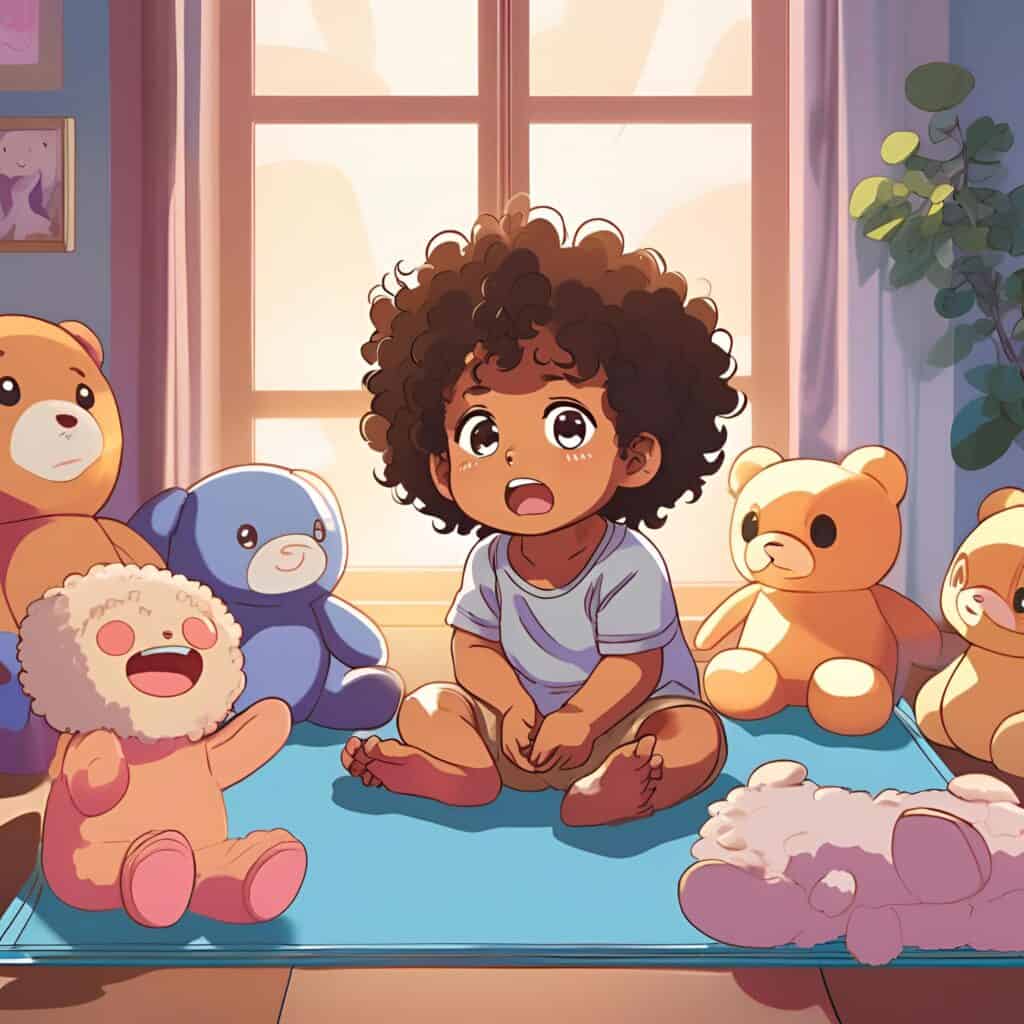Toddler Tantrums: Ten Proven Strategies to Stay Calm & Reduce Meltdowns
Every parent has been there—your toddler suddenly throws a full-blown tantrum in the grocery store, refusing to listen, flailing on the floor, or running off at the worst possible moment. Toddler tantrums are a normal part of development, especially between the ages of 1 and 3, but that doesn’t make them any less exhausting for parents.
The good news? Tantrums are a natural way for toddlers to express big emotions before they have the words to communicate them. While they can’t always be prevented, there are effective ways to manage and reduce their frequency.
In this guide, we’ll explore why tantrums happen, what they mean for your child’s development, and proven strategies to help you handle them confidently and calmly.
Why Do Toddlers Have Tantrums?
Toddler tantrums aren’t just random outbursts—they happen because young children are still developing the skills to communicate and regulate their emotions. When they struggle to express themselves or manage frustration, meltdowns become their coping method.

Here are some of the most common tantrum triggers:
- Limited Language Skills: Toddlers often understand more than they can verbalize, which leads to frustration when they can’t communicate their needs. Boys, in particular, tend to develop speech later than girls, making them more prone to meltdowns.
- Big Emotions, Little Self-Control: Young children experience emotions intensely but haven’t yet developed the ability to calm themselves down when angry, sad, or overwhelmed.
- Hunger, Fatigue, or Overstimulation: A hungry or tired toddler is far more likely to have a meltdown. Loud environments, too much activity, or sudden changes in routine can also overwhelm their senses and trigger a tantrum.
- The Need for Independence: Toddlers want to do things independently as they grow. When they can’t (or aren’t allowed to), frustration can quickly spiral into a full-blown tantrum.
- Seeking Attention & Testing Boundaries: Some tantrums happen because toddlers crave positive or negative attention. They may also test limits to see how caregivers respond to certain behaviors.
Why Your Response to Tantrums Matters
As my son enters the Terrible Twos, I’ve noticed a shift—sudden meltdowns over the most minor things, like wanting to walk in the opposite direction or refusing to leave a store. Since I’m home with him all day, I’ve had more time to reflect on how his emotions affect me and how my response impacts his behavior.
One of my biggest lessons is that childhood experiences often shape our reactions to tantrums. If you grew up in a household where yelling was the norm, your first instinct might be to react the same way. I struggled with this, as I was often yelled at as a child and saw the same patterns in my family.
But recognizing these triggers has been a game-changer. Instead of reacting emotionally, I pause to check in with myself: Am I responding to my child’s emotions, or am I reacting from my past? This self-awareness has helped me manage my emotions and teach my son how to express himself more healthily.
Toddler Tantrum Solutions: 10 Effective Strategies
1. Stay Calm and Respond with Empathy:
Although your child’s tantrum may feel overwhelming, your reaction sets the tone. Before responding, take a moment to assess your emotions. If you feel frustrated or on the verge of reacting negatively, step back if needed.

Ways to Reset Before Responding:
- Take a deep breath and pause before speaking.
- Step into another room for a moment if it’s safe.
- Splash cold water on your face to reset your emotions.
One of the best pieces of advice I received when my son was born was that his mind is a blank slate—he doesn’t come into the world knowing how to handle big emotions. He is learning, just as I am learning with him. That means it’s just as crucial for me to work on my emotional regulation as it is to teach him how to manage his feelings.
- Try saying: “I see you’re upset. It’s okay to feel mad, but let’s use our words.”
- Avoid: Yelling or trying to “fix” the tantrum immediately will only escalate the situation.
When we meet our children’s emotions with patience and understanding, we help them learn that feelings are okay and that there are healthy ways to express them. As we guide them, we also become better, more mindful parents.
2. Validate Their Feelings
Although your child’s tantrum may feel overwhelming, your reaction sets the tone. Before responding, check in with yourself. Are you feeling frustrated? Overwhelmed? About to lose your patience? If so, take a moment to reset before reacting.
- Step back if needed – If you feel yourself reaching a breaking point, step into another room (if safe) or splash cold water on your face.
- Breathe before speaking – Take a deep breath and ground yourself before engaging.
- Reframe your mindset – Remind yourself: They are not giving me a hard time; they are having a hard time.
One of the best advice I received when my son was born was this: His mind is a blank slate. He doesn’t come into the world knowing how to handle emotions—he’s learning, just as I am learning with him. That reminder helps me slow down and guide him rather than reacting to the moment.
- Try saying: “I see you’re upset. It’s okay to feel mad, but let’s use our words.”
- Avoid: Yelling or trying to “fix” the tantrum immediately often worsens things.
3. Offer Simple Choices to Encourage Independence
As your toddler grows, helping them feel a sense of control can prevent meltdowns. They’ll want to pick their outfits, decide what snack to eat, and even assert independence in everyday routines. Giving them small, structured choices helps them feel in charge, without causing chaos.

- Example: Instead of saying, “Put on your shoes!” try, “Do you want your red or blue shoes?”
- Avoid: Open-ended questions like “What do you want to wear?” Too many options can overwhelm them.
This also applies to mealtimes. You may want them to get essential nutrients, but they may refuse certain foods. Sometimes, compromise is key. My son loves rice, but he spits out chicken. Instead of forcing him to eat it, my husband and I cut the chicken into tiny pieces and mixed it into his rice. A minor adjustment can make a big difference!
By involving toddlers in small decisions, they feel more in control, reducing the likelihood of power struggles and meltdowns.
4. Use Distraction and Redirection to Diffuse Tantrums
Toddlers thrive on consistency and structure. A predictable daily routine helps them feel secure and reduces tantrum triggers. Regular mealtimes, naps, and playtimes help them anticipate what’s coming next.
However, life isn’t always predictable. Sometimes, despite your best efforts, you have to improvise.
For example, there are times when the best solution is to remove them from an overwhelming situation altogether. Other times, you might need to tweak their schedule to prevent meltdowns before they happen.
A great example? Daylight saving time. Losing an hour of sleep can completely throw off a toddler’s routine. I’ve learned that preparing for these changes—like adjusting bedtime slightly in the days leading up to it—makes the transition smoother for both of us.
- Tip: Use a visual schedule with pictures to help toddlers understand their daily activities.
- Avoid: Sudden changes without warning—significant shifts often lead to big emotions!
While structure is key, flexibility is just as important. Finding the balance between routine and adaptability will help you and your toddler navigate unpredictable moments with less stress.
5. Keep a Predictable Routine (But Be Ready to Improvise!)

Toddlers thrive on consistency and structure. Predictable meal times, naps, and playtime help them feel secure and reduce tantrum triggers. However, life isn’t always predictable, and there will be times when you have to improvise and figure out how to calm your child in the moment.
For example, the best solution is sometimes to entirely remove them from an overwhelming situation. Other times, you might need to adjust how you approach transitions. Events like daylight savings time can be particularly tricky—especially when losing an hour of sleep throws off their usual routine. Preparing for these disruptions in advance can make the transition smoother for you and your toddler.
- Tip: Use a visual schedule with pictures for daily activities to help them anticipate what’s next.
- Avoid: Sudden routine changes without preparation—significant shifts can lead to big emotions!
While structure is key, flexibility is just as important. Balancing routine with adaptability will help you and your child navigate life’s unpredictable moments with less stress.
6. Use Gentle Touch and Physical Comfort (Find What Soothes Them Best!)
Sometimes, the things that comfort your baby in their early months are the same things that will help calm them during a meltdown. Finding your rhythm and recognizing what soothes your toddler can make all the difference.
For example, when my son was a baby, my husband and I had a lot of skin-to-skin contact to bond with him. Now that he is a little older, holding him close or laying him on my chest often helps him feel secure and calm down faster when he is having a meltdown.
- Example: “I’m here for you. Do you want a hug?”
- Avoid: Forcing physical comfort if they push you away—some toddlers need space before they’re ready for closeness.
Every child is different, so the key is to figure out what works best for your toddler—cuddles, rocking, gentle back rubs, or simply sitting near them while they process their emotions. Once you find what brings them comfort, stick with it and use it as part of your calming routine.
7. Teach Simple Coping Skills (Recognize the Signs Before the Meltdown!)
Sometimes, you can sense your toddler’s frustration building before a complete meltdown. Recognizing these early signals can help you intervene with a calming strategy before things escalate.
For instance, my son is very impatient (he’s an Aries!) and has a naturally fiery temperament. I can tell when he’s about to get frustrated because he taps his fingers impatiently and redirects his gaze to show what he wants or doesn’t want. By noticing these cues, I can guide him toward a coping mechanism before frustration turns into a tantrum.
- Ideas to Teach Coping Skills:
- Deep Breathing – “Smell the flower, blow out the candle.”
- Counting Together – “Let’s count to 5 before we try again.”
- Squeezing a Soft Toy – A gentle way to release frustration.
- Avoid: Expecting them to calm down instantly—it takes practice!
Helping toddlers develop simple self-soothing techniques will give them the tools to regulate their emotions as they grow. And the more you pay attention to their early frustration cues, the easier it will be to redirect them before the meltdown begins.
8. Set Clear Boundaries and Be Consistent (Even When It’s Hard!)
I can always tell when my toddler is about to give me a hard time. In a perfect world, I would be able to sit next to him and breastfeed whenever he pleases, never needing to step away to do chores or take a break. But the reality? The second I need to get something done, he’s behind me, stomping on my feet, pushing me back into the room, or running into me like a bull to keep me close.
I’m still working on teaching him healthy independence, but I’ve realized that having my husband help entertain him is a lifesaver. I can’t always involve him in tasks yet, but as he gets older, I fully intend to.
How to Set Boundaries While Staying Consistent:
- Use Simple Rules – “We don’t hit. If you hit, we take a break to calm down.”
- Follow Through Every Time – If you set a boundary, stick to it.
- Stay Firm, but Loving – Boundaries aren’t punishments; they help kids feel secure.
- Avoid: Giving in to stop a tantrum (e.g., buying a toy because they’re crying).
Toddlers test boundaries daily—it’s their way of learning about the world. The key is to stay patient and consistent, even when they push back (literally!).
9. Praise Good Behavior (And Your Progress!)
It’s easy to focus on the challenging moments, but don’t forget to acknowledge the good ones, too! When your toddler makes a positive choice—like using words instead of yelling—let them know you noticed. Praise reinforces good behavior and encourages them to keep making those choices.
- Example: “I love how you used your words instead of yelling!”
- Avoid: Only giving attention when they act out—focus on reinforcing positive behaviors.
At the same time, don’t forget to recognize your progress. Parenting a toddler isn’t easy, and every time you guide them toward better behavior, you’re doing a fantastic job. Take a moment to feel proud of how far you’ve come in teaching patience, communication, and emotional regulation.
Tip: Keep a small journal or mental note of big and small parenting wins. Seeing progress over time can be a great reminder that your efforts are making a difference!
10. Plan for Tricky Situations (and Bring Their Favorite Toy!)
Sometimes, no preparation can prevent a meltdown, but having a go-to comfort item can make all the difference.
For example, my son loves the abacus—so any toy that allows him to move pieces back and forth in a similar motion helps keep him entertained. When I know we’re heading into a situation where he might get restless, I bring something familiar to help him stay calm.
Ways to Prepare for Tricky Situations:
- Bring Snacks & a Favorite Toy – A minor distraction can help prevent frustration.
- Give a 5-Minute Warning – Before leaving the playground, say, “5 more minutes, then we go.”
- Plan Around Nap & Meal Times – A well-rested, well-fed toddler is less likely to melt down.
- Avoid: Surprising them with sudden changes without any warning.
Sometimes, anticipating their needs and making minor adjustments can save the day (or at least make outings easier!).
FAQs About Toddler Tantrums
Should I ignore a tantrum?
It depends on the situation. If the tantrum is attention-seeking, ignoring it may help prevent reinforcing the behavior. However, if your child is overwhelmed or struggling to regulate their emotions, it’s best to acknowledge their feelings and guide them through calming down.
What if my toddler has a tantrum in public?
Public tantrums can feel stressful, but remember, every parent has been there! Try to:
–Stay calm and focus on your child, not what others think.
–Remove them from the situation if possible.
–Use a quiet, reassuring voice to validate their emotions: “I see you’re upset. Let’s take some deep breaths.”
–Ignore judgment from others—your priority is your child, not what people think.
At what age do tantrums stop?
Most toddlers outgrow frequent tantrums by age 3-4 as they develop better communication and emotional regulation skills. However, occasional meltdowns are still regular, even in older children.
What if my toddler hits or bites during a tantrum?
Stay firm: “Hitting is not okay. I won’t let you hurt me.”
Redirect: Encourage a safe expression of frustration, like squeezing a pillow or stomping feet.
Be consistent: Set and reinforce the same boundary every time so they learn what’s acceptable.
Should I punish my toddler for tantrums?
No. Tantrums are a normal developmental phase, not bad behavior. Instead of punishment, focus on:
- Teaching coping skills (e.g., deep breathing, counting, or using words).
- Setting clear and consistent boundaries without shaming them.
- Modeling calm behavior so they learn by example.
How do I prevent tantrums in the first place?
While tantrums can’t be eliminated, you can reduce their frequency by:
- Keeping a predictable routine—toddlers thrive on structure.
- Offering simple choices to give them a sense of control.
- Ensuring they get enough sleep, food, and downtime to avoid overstimulation.
- Praising good behavior instead of correcting bad behavior—toddlers need positive reinforcement, too!
By understanding tantrums and approaching them with patience and consistency, you can help your child learn to manage their emotions while making life a little easier for yourself!
Final Thoughts
Toddler tantrums can be exhausting, but remember—they are a normal part of childhood development. Your child isn’t trying to be difficult; they are still learning to manage big emotions in a small body.
On the most challenging days, remind yourself:
- You are doing your best.
- Your child isn’t giving you a hard time; they are having a hard time.
- Every small effort you make adds up over time.
Do you need a little extra support? I’ve created a free Toddler Tantrum Reassurance Guide to help you stay calm and confident in the heat of the moment.
- Quick reminders & affirmations to reset your mindset.
- Simple phrases to validate your child’s emotions.
- A calming exercise for when tantrums push you to the edge.
Sign up below to grab your free guide and keep it handy for those challenging moments!
If you’re in the thick of toddlerhood and still healing postpartum, these postpartum self-care ideas might help you feel more grounded again.
Stay Calm Through Toddler Tantrums (Free Download)
Sign up below to grab my free Toddler Tantrum Reassurance Guide—filled with calming affirmations, mindset shifts, and gentle reminders for those tough moments.
No spam, just real talk and helpful mom tips
Already subscribed? Click here to access the Freebie Library.



